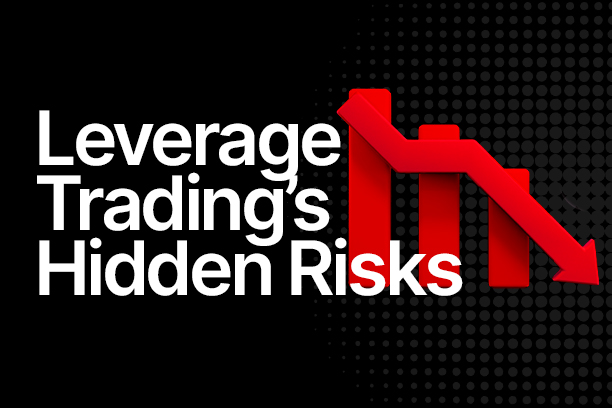Leverage trading has long been an attractive tool for traders looking to amplify their gains, but it remains one of the riskiest strategies in financial markets. The potential for high rewards often blinds traders—both newcomers and seasoned experts—to the crippling risks involved. While some successfully navigate the leverage game, many have lost millions, if not billions, in hours.
During The CoinRock Show, Matthias delved deep into the hidden dangers of leverage trading, highlighting how even the best traders fall victim to its pitfalls. With recent high-profile liquidations in the crypto market, it’s essential to understand why leverage trading is so dangerous and how to manage risk appropriately.
Leverage Trading: Why Do Traders Use It?
Leverage trading enables investors to borrow funds to amplify their position sizes beyond their actual capital. For instance, with 10X leverage, a trader can control $10,000 worth of an asset using just $1,000 of their funds. However, this magnification works both ways: a mere 10% adverse move can wipe out the entire investment.
Matthias aptly describes leverage as “rocket fuel—use it wisely, and you can reach the moon. Use it recklessly, and you explode mid-air.”
While leverage can amplify gains, it equally magnifies losses, making it a high-risk strategy many traders struggle to manage. Notably, 71% of retail investor accounts lose money when trading leveraged products like Contracts for Difference (CFDs). Additionally, a study revealed that a one-unit increase in leverage could lead to an annualized underperformance of 13%, primarily due to margin calls and forced liquidations.
Recent Liquidations: A $308 Million Lesson in Leverage Gone Wrong
In a recent event that underscores the perils of high-leverage trading, a prominent Ethereum (ETH) trader suffered a $308 million loss due to liquidating a 50X leveraged-long position.
What Went Wrong?
The trader anticipated an increase in Ethereum’s price and thus entered a highly leveraged long position, controlling 160,234 ETH (approximately $308 million at the time) with a liquidation threshold set at $1,877.
However, instead of rising, the market experienced a slight downturn, causing Ethereum’s price to dip below the liquidation point. This minor decline triggered an automatic liquidation of the entire position, resulting in a catastrophic loss.
This incident exemplifies the double-edged nature of leverage. While it can amplify gains, it equally magnifies losses. Even seasoned traders cannot predict every market movement, and with high leverage, the margin for error becomes exceedingly narrow.
Reflecting on this case, Matthias commented:
“If you bet your entire fortune on leverage, you’re not trading—you’re gambling. And the house always wins in the end.”
This event is a stark reminder of the inherent risks of leveraged trading, particularly in the volatile cryptocurrency market. Traders should exercise caution and employ robust risk management strategies to avoid similar pitfalls.
Why Even Expert Traders Get Wiped Out
Many assume that only inexperienced traders fall victim to leverage, but history tells a different story. Some of the biggest financial disasters in history were caused by excessive leverage, proving that even top institutions aren’t immune to its dangers.
One of the most infamous examples is the collapse of Long-Term Capital Management (LTCM) in 1998. LTCM, a hedge fund managed by Nobel Prize-winning economists, leveraged its positions up to 25X, expecting to profit from arbitrage in global markets.
However, unexpected market moves—including the Russian financial crisis—led to $4.6 billion in losses. The situation became so dire that the Federal Reserve had to step in and organize a bailout to prevent a wider financial collapse.
A decade later, excessive leverage played a central role in the 2008 financial crisis. Major banks like Lehman Brothers and Bear Stearns over-leveraged their exposure to mortgage-backed securities, fueling a massive housing bubble.
When the housing market collapsed, these firms suffered billions in losses overnight, triggering a chain reaction that led to the biggest financial meltdown since the Great Depression.
These examples prove that even experts, institutions, and top traders can miscalculate market conditions, leading to total financial ruin. Whether in traditional finance or crypto, excessive leverage remains one of the most dangerous forces in trading—one that can wipe out fortunes in the blink of an eye.
The Hidden Risks of Leverage Trading
Crypto markets are notoriously volatile, with 10%–20% price swings in a single day being fairly common. If a trader is using 20X leverage or more, even a small market move against them can completely erase their position, leaving them with nothing. This extreme volatility makes high-leverage trading highly risky, especially for those who fail to manage their exposure properly.
Another major risk comes from forced liquidations by exchanges. Unlike traditional investments where traders decide when to sell, leveraged positions have liquidation prices set by the exchange. If a trader’s position reaches this liquidation threshold, the exchange automatically sells their assets, often at a massive loss, without giving them a chance to react.
Additionally, market manipulation and stop hunts are common tactics used by large institutional traders. These entities often push prices just low enough to trigger the liquidation of high-leverage traders before reversing the trend. This practice, known as “stop hunting,” forces small traders out of their positions, allowing larger players to enter at better prices.
Matthias explains this harsh reality:
“If you’re trading with high leverage, just know that the market sharks can smell blood from a mile away.”
These risks highlight why even experienced traders struggle with high-leverage trading, making it more of a gamble than a calculated strategy for most participants.
How to Avoid Leverage Trading Disasters?
Leverage isn’t inherently bad, but it must be used responsibly to avoid catastrophic losses. One of the most important rules is to use low leverage, ideally under 5X, as anything beyond 10X becomes extremely risky, even for professional traders. Additionally, traders should always set stop-loss orders, defining a clear exit point before entering a trade to limit potential losses.
Another crucial principle is never to bet your entire portfolio on leverage trades. Instead, traders should keep leveraged positions at a small percentage of their overall holdings to avoid wasting their entire investment in a bad trade.
Understanding market conditions is equally important—leveraged trading should be avoided during highly volatile events such as CPI reports, Federal Reserve meetings, or major economic announcements, as these events can trigger sudden, unpredictable price swings.
Lastly, traders must resist the temptation of revenge trading. Trying to win back losses by increasing leverage is one of the most common mistakes, often leading to even greater losses and eventual liquidation. By following these principles, traders can minimize risks and use leverage as a tool rather than a gamble.
Is Leverage Worth the Risk?
Leverage trading is not for the faint-hearted. While it can boost profits, it more often destroys fortunes—even for the most experienced traders. History is littered with examples of institutions and individuals who thought they could outsmart the market, only to end up bankrupt overnight.
Matthias leaves traders with a final word of caution:
“The smartest traders aren’t the ones making the biggest bets—they’re the ones who know when to walk away.”
Before jumping into leverage trading, ask yourself: Are you trading smart, or just rolling the dice?





